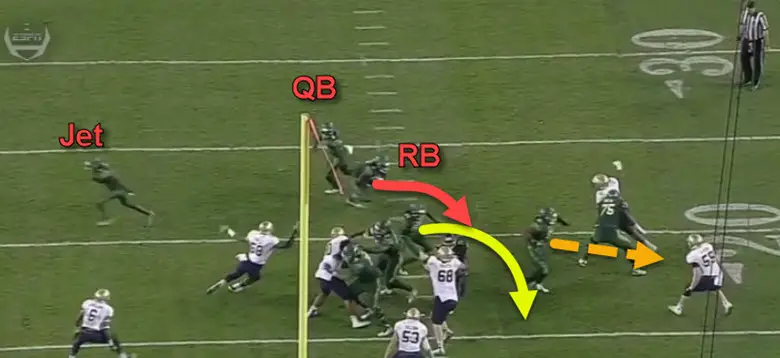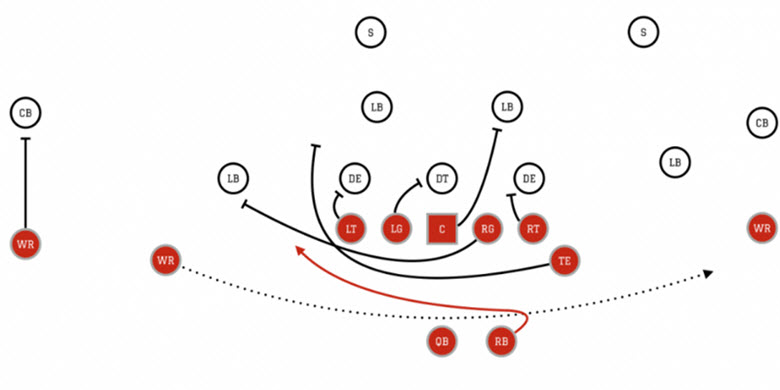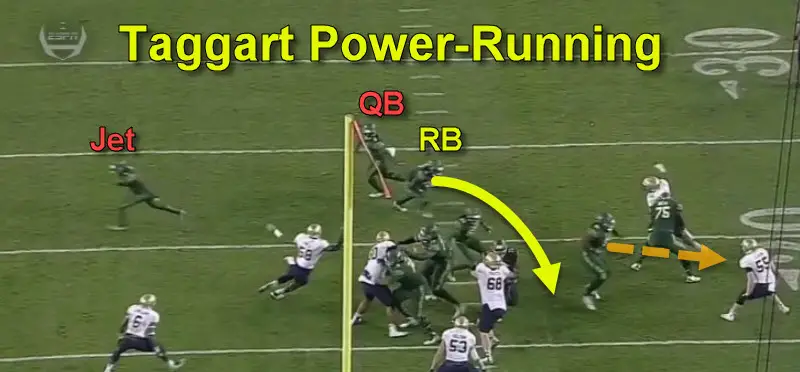In our last FishDuck.com analysis, we showed how the classic off-tackle power blocking scheme has been adapted to the Spread Offense. While those play possibilities are interesting and exciting to me, I am more looking forward to the several ways the Oregon Ducks might merge the Counter Trey into their Smash-Mouth … with deception, offense.
The Counter Trey
Coach Tom Osborne of Nebraska is credited with inventing the Counter Trey in the early ’80s, and Coach Joe Gibbs’s Washington Redskins certainly popularized it in the mid-’80s.
What is the Counter Trey?

A play of deception and power…
The play gets its name because three offensive players quickly attack to the side of the line opposite the initial flow of the offensive backs. The offensive line blocks almost exactly the same as on a power [the offensive linemen block “down” – away from where the ball is going – with a double-team block by the two widest linemen], but now the off-side guard blocks out on the defense’s contain man, and “another” blocker [it could be the off-side tackle or TE, a RB, or an H-back] leads the RB through the hole inside the guard’s kick-out block.
Being able to have the same blocking assignments on two such significant plays is a huge advantage for the offense.
So how do Spread Offense teams apply Counter-play blocking?

Jet-Motion Counter Trey
By using the Jet Sweep action (above) away from the Counter Trey to hinder the defense’s reactions.
“One great fake equals two great blocks.”
The Counter is a great combination of power and deception that starts with the backfield appearing to go to one side, and then quickly hitting back to the opposite side. Just that brief deception momentarily freezes the LBs and allows the power blocking scheme to be more effective.
Note on the previous play there is no read by the QB, as the backside offensive tackle has to block the backside defensive end.
The Quarterback Counter
And now it gets really good – especially if the quarterback is a good runner. There are just not enough players to adequately defend a good running quarterback and still adequately defend the other guys. And remember, the offense has an extra blocker, who didn’t have to block the “read” defender.
The quarterback can use the same read of the unblocked defensive contain man he used in the Jet Sweep-Inverted Veer. If the read defender doesn’t come upfield quickly, the quarterback can give to his Jet Sweep running back.
And if the read defender stops the Jet Sweep, the quarterback, instead of running a power to the same side, runs a more deceptive – and usually more effective – QB Counter to the opposite side, as South Florida did, above, against the Seminoles. The read defender/DE now cannot catch the QB from behind, so he doesn’t have to be blocked.
The Sweep Read could also be made to a stationary running back, instead of a Jet Sweeper.
Clemson’s quarterback, Deshaun Watson, killed Alabama with the Quarterback Counter play in the National Championship game last January.
Remember the Toss Read I wrote about in the previous article? I think it will be a big part of the Ducks’ 2017 offense. This Quarterback Counter can be used together with a fake Toss Read, instead of the Jet Sweep action. (Clemson really hurt Ohio State with that play)
Finally, for this article, the creme de la creme; the coup de grace:
How about having to defend on the same play:
1. A Jet Sweep, with a lead running-back blocker.
2. A Quarterback Counter, with pulling offensive linemen to the opposite side.
3. And then have the quarterback–instead run an off-tackle power, with a lead blocker to the side of the original Jet Sweep action? (See Video below!)
How’s that for deceptive Power football?
(FishDuck Note: Adding to the deception and the power running threats are the options of play-action passes downfield, or the Bubble Screen out wide for five threats in one play!)
In the play above, note how the defensive end takes himself out of the play by trying to avoid the running back’s block. And how the H-back can pick-off the first linebacker to the inside, giving the quarterback plenty of room to run.
Yes, Power football is … powerful stuff. And as Coach Taggart found out at South Florida, the ability to read unblocked defenders and the deception that can be created by a Spread Offense can really enhance the effectiveness of his Smash-Mouth T-formation offense.
It’s going to be a lot of fun for us watching Coach Taggart‘s Oregon offense evolve.
Retired Coach Mike Morris (Grizzled Ol’ Coach)
Pleasant Hill, Oregon
Top Photo from Video
Coach Mike Morris spent 30 years coaching at seven different high schools throughout Southern California. He coached many players who went on to Pac-12 programs including Oregon, such as Saladin McCullough. He is a writer, Football analyst and a good friend of the Principal of the site.

